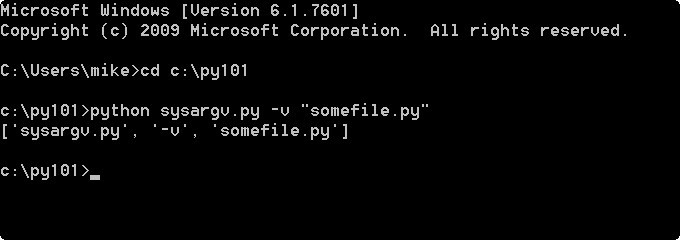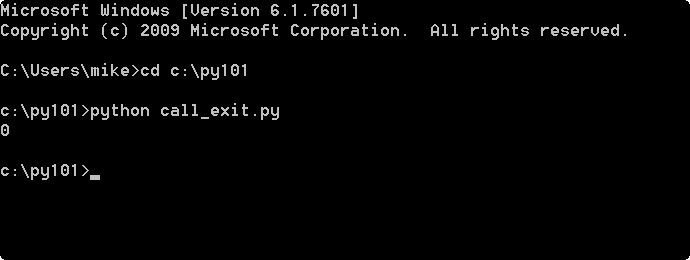Chapter 20 - The sys Module¶
The sys module provides system specific parameters and functions. We will be narrowing our study down to the following:
- sys.argv
- sys.executable
- sys.exit
- sys.modules
- sys.path
- sys.platform
- sys.stdin/stdout/stderr
sys.argv¶
The value of sys.argv is a Python list of command line arguments that were passed to the Python script. The first argument, argv[0] is the name of the Python script itself. Depending on the platform that you are running on, the first argument may contain the full path to the script or just the file name. You should study the documentation for additional details.
Let’s try out a few examples to familiarize ourselves with this little tool:
>>> import sys
>>> sys.argv
['']
If you run this in the interpreter, you will receive a list with an empty string. Let’s create a file named “sysargv.py” with the following contents:
# sysargv.py
import sys
print(sys.argv)
Now run the code in IDLE. You should see it print out a list with a single element that contains the path to your script in it. Let’s try passing the script some arguments. Open up a terminal / console screen and change directories (use the “cd” command) to where your script is. Then run something like this:

You will notice that it outputs the following to the screen:
['sysargv.py', '-v', 'somefile.py']
The first argument is the name of the script we wrote. The next two arguments in the list are the ones we passed to our script on the command line.
sys.executable¶
The value of sys.executable is the absolute path to the Python interpreter. This is useful when you are using someone else’s machine and need to know where Python is installed. On some systems, this command will fail and it will return an empty string or None. Here’s how to use it:
>>> import sys
>>> sys.executable
'C:\\Python27\\pythonw.exe'
sys.exit¶
The sys.exit() function allows the developer to exit from Python. The exit function takes an optional argument, typically an integer, that gives an exit status. Zero is considered a “successful termination”. Be sure to check if your operating system has any special meanings for its exit statuses so that you can follow them in your own application. Note that when you call exit, it will raise the SystemExit exception, which allows cleanup functions to work in the finally clauses of try / except blocks.
Let’s take a look at how to call this:
>>> import sys
>>> sys.exit(0)
Traceback (most recent call last):
File "<pyshell#5>", line 1, in <module>
sys.exit(0)
SystemExit: 0
When you run this code in IDLE, you will see the SystemExit error raised. Let’s create a couple of scripts to test this out. First you’ll want to create a master script, a program that will call another Python script. Let’s name it “call_exit.py”. Put the following code into it:
# call_exit.py
import subprocess
code = subprocess.call(["python.exe", "exit.py"])
print(code)
Now create another Python script called “exit.py” and save it in the same folder. Put the following code into it:
import sys
sys.exit(0)
Now let’s try running this code:

In the screenshot above, you can see that the exit script we wrote returned a zero, so it ran successfully. You have also learned how to call another Python script from within Python!
sys.path¶
The sys module’s path value is a list of strings that specifies the search path for modules. Basically this tells Python what locations to look in when it tries to import a module. According to the Python documentation, sys.path is initialized from an environment variable called PYTHONPATH, plus an installation-dependent default. Let’s give it a try:
>>> import sys
>>> print(sys.path)
['',
'C:\\Python27\\Lib\\idlelib',
'C:\\Python27\\lib\\site-packages\\setuptools-0.9.5-py2.7.egg',
'C:\\Python27\\lib\\site-packages\\pip-1.3.1-py2.7.egg',
'C:\\Python27\\lib\\site-packages\\sphinx-1.2b3-py2.7.egg',
'C:\\Python27\\lib\\site-packages\\docutils-0.11-py2.7.egg',
'C:\\Python27\\lib\\site-packages\\pygments-1.6-py2.7.egg',
'C:\\Windows\\system32\\python27.zip', '
C:\\Python27\\DLLs',
'C:\\Python27\\lib',
'C:\\Python27\\lib\\plat-win',
'C:\\Python27\\lib\\lib-tk',
'C:\\Python27',
'C:\\Python27\\lib\\site-packages',
'C:\\Python27\\lib\\site-packages\\PIL',
'C:\\Python27\\lib\\site-packages\\wx-2.9.4-msw']
This can be very useful for debugging why a module isn’t getting imported. You can also modify the path. Because it’s a list, we can add or delete paths from it. Here’s how to add a path:
>>> sys.path.append("/path/to/my/module")
I’ll leave deleting a path as an exercise for the reader.
sys.platform¶
The sys.platform value is a platform identifier. You can use this to append platform specific modules to sys.path, import different modules depending on platform or run different pieces of code. Let’s take a look:
>>> import sys
>>> sys.platform
'win32'
This tells us that Python is running on a Windows machine. Here’s an example of how we might use this information:
>>> os = sys.platform
>>> if os == "win32":
# use Window-related code here
import _winreg
elif os.startswith('linux'):
# do something Linux specific
import subprocess
subprocess.Popen(["ls, -l"])
The code above shows how we might check to see if we’re using a particular operating system. If we’re on Windows, we’ll get some information from the Window’s Registry using a Python module called _winreg. If we’re on Linux, we might execute the ls command to get information about the directory we’re in.
sys.stdin / stdout / stderr¶
The stdin, stdout and stderr map to file objects that correspond to the interpreter’s standard input, output and error streams, respectively. stdin is used for all input given to the interpreter except for scripts whereas stdout is used for the output of print and expression statements. The primary reason I mention this is that you will sometimes need to redirect stdout or stderr or both to a file, such as a log or to some kind of display in a custom GUI you have created. You could also redirect stdin, but I have rarely seen this done.
Wrapping Up¶
There are many other values and methods in the sys module. Be sure to look it up in the Python documentation, section 27.1. You have learned a lot in this chapter. You now know how to exit a Python program, how to get platform information, working with arguments passed on the command line and much more. In the next chapter, we’ll be learning about Python threads!